This study is the result of a collaborative effort between Philip E.H. Thomas, the author, and Gordon R. Charlton, the compositor.
TH stands for Templum Hierosolymae - the Temple at Jerusalem. (The Craft - John Hamill.)
The Influence of Joseph - Joseph enslaved in Egypt. Appointed Vizier. Prosperity and famine. The Jewish Sojourn.
Prelude to the Exodus - The Jews in Bondage. Moses warns Pharaoh. The Ten Plagues.
The Exodus - Crossing the Red Sea. The Parting of the Waters. Camping at Mount Sinai.
The Ark of The Covenant - Moses receives the 10 Commandments. Description of the Ark and Tabernacle.
Wandering in the Wilderness - The Search for the Promised Land. Moses dies in sight of Jericho.
The Promised Land - Joshua succeeds Moses. The Fragmentation of the Tribes. First loss of the Ark and Recovery.
A Yearning for Unity - Appointment and suicide of Saul. David becomes King of Israel.
Jerusalem - the First Capital - David seizes Jerusalem and plans Israel's First Capital.
The Concept of The Temple - David buys the Temple Site. Ark moved to Mount Zion. The numbering of the Tribes. A Sacrifice on Mount Moriah.
The Selection of Solomon - Solomon continues David's Vision of a new Jerusalem. Work starts on Foundations of The Temple.
The Temples
Building the First Temple - Phase 1 - Hiram, King of Tyre provides Materials. Adoniram directs the Work Force.
Building the First Temple - Phase 2 - A Description of the Temple and its Construction.
Hiram Abif - Invitation to Hiram. Description of the Columns, Cisterns and Altars.
The Dedication - Queen of Sheba impressed in State Visit.
The Divided Monarchy - Israel divides after Solomon's Death. Nebuchadnezzer II takes control of Jerusalem.
The Destruction of the First Temple - Jerusalem sacked by Nebchadnezzer's Forces. The Ark disappears.
The Great Exile - 5,000 Jews banished to Babylon. Zedekiah's alleged treachery. King Cyrus captures Jerusalem. Treasures returned.
Building the Second Temple - A Description of the Temple. Delays in building works. Herod's enhancements. The Masonic Hall.
The Destruction of the Second Temple - Romans take Jerusalem. Jews banished. Mosque of Sakhra built on Site of Solomon's Temple.
Epilogue - Israel, a Nation divided.
Appendices
A. The New Chronology of Egypt
A1. The Basis of its Establishment
A2. The New Datum of 1012NC
A3. The New Datum of 1540NC
B. Selected Biblical References
C. Main Line Rulers of Egypt
D. Selected Biblical Measurements
E. Kings of Israel
F. Brief Summary of Biblical History
G. Selected Bibliography
H. Acknowledgements and Sources for Illustrations
This document has been prepared primarily for the interest of all Freemasons whose Constitutions are recognised by the United Grand Lodge of England. That does not mean that it is private to Freemasons only; it is not, nor can it be. It deals essentially with Biblical facts insofar as it has been possible to establish them with reasonable confidence. In so doing, it encompasses that portion of Biblical history which, in essence, forms the bedrock of much Freemasonic ritual; not only within the Craft but within the Holy Royal Arch as well.
In assembling this presentation, it is important to appreciate that many learned books have been written about the Old Testament. The Exodus of the Israelites from Egyptian captivity, culminating in the eventual establishment of a homeland under the rule of David and then Solomon, is an account that is both fascinating and controversial.
Following publication of the Authorised King James I Bible in 1661, the calendar of events therein were set against a starting date of 4004 BCE which was regarded as the beginning of Creation: (Anno Lucis began in 4000 BCE). Since CE 1850's, there has been a tendency to examine and have a deeper insight of its writings by focusing on the cradle of its origin - the Middle East.
When Egypt was a condominium of Great Britain and France, a few wealthy archaeologists had begun to search and dig around the spectacular monuments and relics that were there for all to see. This, in turn, led to the exploration and excavation of many hidden tombs. When, in CE 1922, the tomb of Tutankhamun was discovered and opened up, its treasures motivated such enterprises to further heights. Detailed studies were made of the hieroglyphic signs, cuneiform inscriptions and papyrus script as well as the Akkadian language which was the lingua franca of those times. The advent and development of sophisticated electronics, coupled with the latest evolution in scientific skills, has speeded up both the desire and facility to achieve historical precision.
The purpose of this document is to offer an updated, yet easily digestible, précis of this part of Biblical history and the events that led up to it. Account has been taken of the latest archaeological discoveries and associated astronomical retrocalculations. These, in turn, have necessitated a reappraisal of ancient Egyptian chronology in order to bring such history much more in line with the facts, rather than with long-held supposition.
To introduce greater authenticity into this narrative, the newly acquired data has been embodied. This, in turn, has meant amending the hitherto conventional dates in order to incorporate what is coming to be recognised as The New Chronology of Egypt. The background and basis of how The New Chronology has come to be established is laid out in some detail at Appendix A.
The Old Testament is, amongst other things, an assembly of 39 books covering various notable events in the Middle East, and particularly the Levant, from about 4000 BCE to 395 BCE. The Apocrypha, of 15 books, which is not included by the Anglicans, then takes us up to the birth of Jesus.
It is worth remembering that such history in the earlier years, not only described true happenings but was also richly embellished with legends. Consequently, over the ages, these narratives became distorted and often exaggerated; in fact, varying versions of the same episode were repeated several times over. For example, the story of the First Temple in Jerusalem is to be found in the Books of Samuel, Kings, Chronicles, Jeremiah and Ezekiel; and that of the second Temple in Ezra, Haggai, Zechariah and parts of the Apocrypha.
On the other hand, many learned and influential scholars today argue that accurate and substantiated Israelite history only began with the Solomonic Age. This is because, surprisingly, virtually no contemporary evidence exists in support of earlier events that affected the Israelites. For that, we need to turn to those Egyptian and Assyrian records that have survived.
The following study, based as it is upon the most recently published archaeological and textual information available, and centring upon these two Temples, at times differs from accounts in the Holy Bible. This, however, must not be interpreted as an attempt to belittle or scorn the latter, nor to diminish the spiritual messages that it contains.
Although the death of King Solomon in 931 BCE was once regarded as the first secure and irreproachable date in Biblical history, it has become possible to move this datum backwards as far as 1540 BCE; namely, 13 years before the birth of Moses. Thus, for the purpose of this presentation only, any date mentioned which is prior to the death of King Solomon in 931 BCE, will carry the suffix 'NC' instead of the usual 'BCE'. Dates following Solomon's death may be regarded as fairly accurate; certainly to within one year.
The span and content of this overview is so huge that, for the sake of brevity, it has been necessary either to condense or exclude many anecdotes which, albeit absorbing in themselves, do not directly affect the main substance of this particular narrative.
(Numbers in brackets link to the appropriate Biblical references at Appendix B)
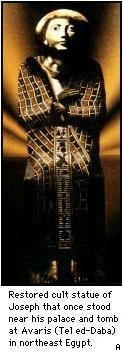
To truly understand the reasons for having any temple at Jerusalem, one really should begin with the Exodus of the Israelites from Egypt. This has now been firmly established as having taken place in the year 1447 NC; in the reign of Dudimose; the last Pharaoh of the 13th. Dynasty, (1448-1440 NC). (See Appendix C) Hitherto, Ramesses II had always been held responsible for cruelty to the Jews during the Oppression or Bondage and which ended with the Exodus. Whereas in fact he was of the 19th. Dynasty and reigned nearly 500 years later. There will be more about him further on.
Up until the time of the Exodus, the Israelites had lived and worked in Egypt for almost 215 years (1). Joseph (Yoséf) was, in fact, the first to lead his people from Canaan to Egypt, albeit unintentionally. This arose because seven of his brothers, jealous of his obvious high intelligence, had kidnapped him, thrown him into a well, and were contemplating the means of his death, when a passing caravan of Midianites presented a more convenient solution. Instead, therefore, Joseph was sold to them, and the Midianites in turn sold him as a bonded slave to Potiphar, head of the Royal Guard at Memphis. This was in 1683 NC and Joseph was barely seventeen years old.
After a while, his new situation attracted the amorous attentions of Potiphar's wife, but Joseph would have none of them. Consequently, he was imprisoned on the false charge of sexual harassment. Whilst in prison, he befriended two former courtiers and, through them, acquired a reputation for accurate interpretations of dreams.
Upon his release, one of these courtiers later told Pharaoh Amenemhat III, Pharaoh of Upper and Lower Egypt. The king became curious, as he himself had been bedevilled by the recurring dreams of seven lean cows eating seven fat cows. Joseph was brought before Pharaoh to give his interpretation. This amounted to a warning that Egypt would enjoy seven prosperous years but that this would be followed by seven years of famine. Joseph advised prudence and comprehensive planning. Pharaoh was so impressed that he promoted Joseph immediately to the post Vizier. So it was in 1670 NC, that Joseph became the most powerful man in the country, second only to Pharaoh himself. He was now aged thirty.
Eight years later, with the predicted famine having its effect, Joseph encouraged his father, Jacob (Ya'akóv), together with a large number of relatives and other Jews, to emigrate to Egypt from Canaan in order to enjoy the benefits of Joseph's husbandry, and to begin what became known as The Sojourn.
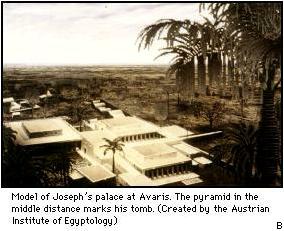
Jacob and many of his family and followers settled in the district of Goshen in northeast Egypt. Jacob himself built his home at Avaris. Some 17 years later, Jacob died and Joseph then had a palace constructed on top of the foundations of his father's former residence.
Joseph went on to serve 10 Pharaohs. Indeed, at one time he was the sole ruler of Egypt for six years (1625-1619 NC) until a new Pharaoh could be chosen. He was over 100 years old when he died and was buried within a mausoleum adjoining his palace.
Over the ensuing years the Jews were very successful; so much so that the Egyptians became nervous and jealous of their growth and influence (2). Eventually, Pharaoh Sobekhotep IV ordered that the Jews be taken into oppressive slavery and that their population be controlled by infanticide. Thus the last 70 years of The Sojourn came to be known as The Bondage.
Meanwhile, Moses [Moshé, 'drawn (from water)'] was born near Memphis in 1527 NC and subsequently enjoyed a royal upbringing. Indeed, he became ranked as a Prince of Egypt and a successful military commander. His successes were such that Pharaoh Ay became very jealous of him and his popularity. He, therefore, was forced to flee into exile in Saudi Arabia in 1493 NC where he married and stayed for the next 44 years. It was not until 1449 NC, and after a number of urgent appeals from the Jewish communities that prompted Moses to return to Egypt.
Moses, now 78 years old, tried to persuade the newly crowned King Dudimose to release the Israelites, but he was steadfastly refused. Despite warnings from Moses, the afflictions started in 1448 NC in the form of what have come to be known as the ten plagues; e.g. frogs, flies, locusts, etc. (3). The eighth and ninth occurred both together the same night. The first was an unprecedented violent hail storm, followed closely by a catastrophic earthquake. The Black Land (a name at that time given to the whole of the Nile Delta north from Memphis, i.e. 10 miles (16 km) south of Cairo) was devastated: houses, roads, canals, and even the largest temples were all wrecked.
Of all the tribulations that beset the populace, there now occurred an event which has so far defied any clear and rational explanation: all newly-born children began to die; not necessarily all at once, but patently over a short period. No mention has ever been made as to whether Jewish babies suffered the same fate; in all probability they did as even animals were similarly afflicted. There is no question but that this disaster did occur, for widespread and haphazardly filled death-pits of that period, with animals and humans mixed up together, have been unearthed relatively recently and identified as belonging to this episode. At all events, this tragedy proved too much for Dudimose, and he now acceded to Moses' demands. Before being allowed their freedom, however, the Jews were first obliged to carry out all these burials themselves.
Then, having been joined by a number of Asiatics, they abandoned their homes and evacuated their principal store cities of Avaris and Pithom, in the district of Goshen. So began their trek eastwards to Canaan. Other workers, mainly Asiatics, similarly seized this opportunity to flee southwards in terror and en masse to get away from the stricken land.
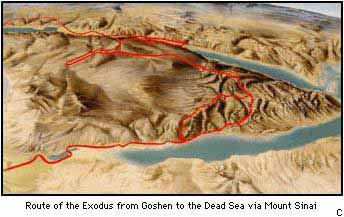
It is written that 600,000 men left (4). This is obviously a gross exaggeration as it would have meant a mass departure of well over 2 million people; far more than the population of the whole of Egypt in those days. (Even over 3200 years later, in 1800 AD, the population was only four million.) It is now thought that the Exodus, comprising the descendants of Benjamin, Jacob and Joseph, could not have been more than 150,000 all told, and probably a lot less. Even a multitude of this size surely must have posed enormous problems of logistics. In accordance with his written wishes before his death in circa 1600 NC, at the extraordinary age of 100+ years, Joseph's remains were removed from his tomb at Avaris and taken away by the Jews for eventual reburial in Canaan (5). It is generally believed that Joseph's final resting place is at 'Joseph's Tomb' in Shechem (now known as Nablus in the territory recently handed to the Palestinians).
Although the shortest route to Canaan lay eastwards along the Mediterranean coastline, it was well known that extensive military fortifications lay between the sea and the mountains to the north-west of the Sinai Peninsular. They existed to repel the marauding Philistines [Plishtim, 'invaders (from the sea)'] who occupied land extending north-eastward past what is now known as Gaza. In consequence, Moses had no choice but to head south-eastwards in order to follow the only alternative route which ran across the top and then down the eastern side of the Gulf of Suez. In those days, widespread reed marshes and salt pans lay between what is now Suez and the Bitter Lakes. The Hebrew word for 'Red Sea' is the same as the 'Sea of Reeds'. Incidentally, the reed subsequently became a unit of measurement. (See Appendix D)
The Jews had almost completed their crossing of the Sea of Reeds when Dudimose changed his mind as a consequence of political pressure for the return of the slaves. Thus he ordered units of his army, made up mainly of the newly evolved chariots, to re-arrest them. The story of the waters parting to allow the Jews passage is well known (6). The actual event, let alone its crossing place, nevertheless is so shrouded in tradition and legend that this cannot be confirmed. One needs to bear in mind that in those days it was Egyptian practice never to document failures of any kind; archivists and scribes were only prepared to record military victories and other notable achievements. However, if this particular account could be based on any substance, the actual crossing of this stretch of marshland might conceivably have been achieved during a period of neap tides at the head of the Gulf of Suez, coupled with strong northerly winds: whilst, on the other hand, it is equally possible that Pharaoh's pursuing forces might have suffered wholesale inundation from a combination of spring tides and severe southerly storms. The range of Spring tides at Suez is 8.0 feet (2.4 m) and Neap tides is 2.9 feet (0.9 m).
With his need to ensure an adequate water supply, Moses was obliged to follow the established road past the existing copper and turquoise mines that lay along the eastern side of the Red Sea. Eventually, he and his followers ended up camping for quite a time on the plain at the foot of Mount Horeb in Mount Sinai.
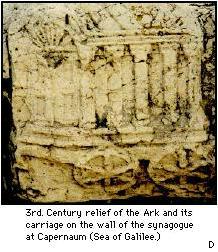
By the time the bulk of the Jews had assembled at Mount Horeb, Moses was an old man in his 80's. It was here that he received the Ten Commandments. The account of him bringing these down Mount Sinai, in the form of two stone tablets, is certainly questionable, particularly as he is reported to have done so twice (7). It would seem more likely that he received the Commandments in inspirational form, and then had them set to stone once he had returned to his people. It is highly improbable that he could ever have twice carried down those heavy stone slabs from some way up a rocky 7000’ (2150 m) mountain, let alone after 40 days without sustenance. Furthermore, the Apocrypha seems to confirm this, in that Moses was commanded "to write the Laws in the presence of the people of Israel." (8).
In due course, a special gold-encased Covenant Box of acacia wood, called the Ark, and supported by two long gold-encased wooden poles, was made in which to carry the now Sacred Tablets with their engravings. It was not large; it measured approximately 50 x 30 x 30 inches (1.20 x 0.75 x 0.75 m). Nevertheless, it would have been heavy enough with all its gold cladding and embellishments, besides containing the two Tablets and other sacred artefacts. (9).
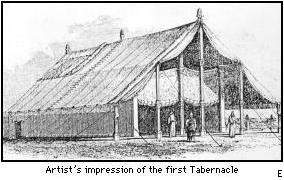
Although there appears to be no Biblical evidence to support this, it seems both logical and reasonable to assume that some time later the Ark, together with its adornments and carrying poles, was transported by means of a four-wheeled cart. Later accounts of the movement of the Ark, as reflected in both Books of Samuel, seem to imply this. The Ark itself was always kept carefully veiled whenever outside the large tented Tabernacle. The Tabernacle itself had been devised soon after the construction of the Ark, and was always erected whenever the Israelites were likely to remain static for any length of time.
In due course, the tribe of Levi was designated as the future source of hereditary priests appointed to guard the Ark.
The Jews continued their wanderings in the wilderness in search of their Promised Land, and from whence their ancestors had originated some 220 years previously. The route of the Exodus is not known for certain and probably never will be. There were no maps in those days. Indeed, they would not be conceived until 580 BCE by Anaximander of Miletus in Greece, i.e. some 870 years later. Nowadays, Anaximander is generally recognised as having been the world's first cartographer. Consequently, scouting parties (spies) needed to be sent out to determine the best line of advance.
In the main, their travels took the Israelites up the east coast of Sinai. After a number of false trails, and with stops at times lasting several years, they eventually ended up along the eastern side of the Dead Sea (Salt Sea). So it was that, after 37 years and a journey of about 650 miles (1045 km), they reached Mount Nebo, adjacent to the northeast corner of the Dead Sea. Jericho was clearly visible on the other side of the river Jordan. It was here, in 1410 NC, that Moses is reported to have died, although his burial place has never been traced. If true, he would have been 117 years old!
Joshua (Yehoshûa'), who had been the military commander for some years during the latter part of the Exodus, now took over from Moses. He led the Israelites to conquer Jericho. In fact he so destroyed both the city and its population that it remained abandoned for centuries thereafter. He then went on to conquer the whole of the hill country of Canaan as far as Hazor, five miles (8 km) north of the Sea of Galilee. On the way, he took Shechem and Shiloh. The hilltop town of Shiloh thereafter became the permanent resting place of the Ark and its Tabernacle for the next 400 years or so.
Following the death of Joshua, the tribes tended to fragment under their own separate leaders, who would come to be known as The Judges. Four tribes headed south-west, whilst the remaining eight spread over towards the coast and northwards to roughly level with Hazor. It was inevitable that they would all become involved in frequent and continuing skirmishes with various city-states or minor kingdoms in order to secure land for themselves. This turbulent state of affairs lasted until 1010 NC.
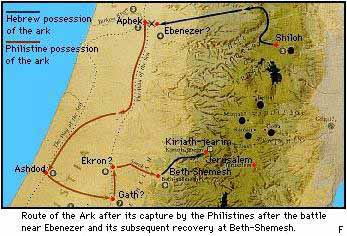
On one occasion, during the time of Samuel (Shmuél) who was the last of the great Judges, the Israelites were engaged in a fierce struggle against the Philistines around Ebenezer. Learning that the battle was going badly, Eli the High Priest ordered his two sons to take the Ark to the battle area to give heart to his countrymen. For all that, the battle was lost and both his sons were killed. The Ark was captured (10). Meanwhile Eli, who was a short plump man, had been sitting quietly on top of a stone wall awaiting the outcome when news of the defeat reached him. He was so shocked, he toppled backwards and broke his neck.
Somewhat surprisingly, after only seven months, the Philistines asked the Israelites to take back the Ark. It seemed that they had suffered from sudden and widespread sickness which they attributed to its unlawful possession. The Ark was hastily recovered and brought on a makeshift wagon to Kiriath, eight miles (13 km) west of Jerusalem where it was again rehoused in its former Tabernacle (11).
By this time almost all the Israelite tribes yearned for the peace and stability that they believed could come with re-unification. Accordingly, they appealed to Samuel to select a leader whom they could call King 'like the other nations'. He chose and anointed one Labayu who, after his death, came to be known as Saul [Shaûl, 'asked for (by the people)']. His people always referred to him as 'Great Lion of G-d'. (See Appendix E)
King Saul spent most of his reign fighting the hill tribes and Philistines. A rebel chieftain, called David, became prominent with his large contingent of Hebrew mercenaries who owed allegiance to no particular tribe. David himself was of the tribe of Judah having been born of humble origins in Bethlehem. Eventually, Saul put David to flight and the latter sought refuge in the kingdom Philistia.
As a revenge on Saul, David offered his force to the Philistines whom he knew were about to mount their own attack on Saul, but his gesture was refused as the Philistines did not altogether trust him. The eventual outcome was that, in Saul's final clash with the Philistines on Mount Gilboa, he was betrayed by a section of his own troops which resulted in his total defeat. Three of Saul's sons, including Jonathan, were killed and Saul himself committed suicide. The four bodies were decapitated and their heads suspended from the walls of the nearby city of Bethshean.
Meanwhile, David had moved in and taken control as king of the city-state of Hebron, where some time previously he had married Saul's daughter, Michal. Saul's remaining son, Ishbaal, now inherited the kingdom but he reigned very ineffectually for only seven years before contracting an illness from which he died. Whereupon, David promptly exploited his position as Saul's son-in-law and assumed the kingship of the whole of Israel.
For most of his reign, David was obliged to conduct many bloody but, in the main, skilful campaigns to establish full sovereignty thereby to foster the unity of his people within a stable and wealthy economy. It was, therefore, not until much later in his life that he resolved to build a permanent temple - 'A House for G-d' - within which to retain the Ark. One is led to suppose that, in size, the proposed temple was to take the form more of a Royal chapel than a full scale temple in the accepted sense; nevertheless, David's aim was to make it the centrepiece of his proposed seat of government, as well as the religious focus of the Jewish nation. Hitherto, there had been no co-ordination of the country's administrative affairs, except in military matters. David was resolved to put this right.

As a first step, David seized the small township of Jerusalem (its ancient name was Shalem) with the intention of creating his country's capital. He did this for two reasons: first, for the political reason that Jerusalem was located close to the territorial division between the tribes of Judah and Israel; second, because he was attracted to the unusually conical shape of one of the three hills lying just north of the township. Later it came to be known as Mount Moriah, with Mount Zion to the west and Mount of Olives to the east. Another advantage was that Mount Moriah had its own ample water supply which was derived from streams coursing down the Kidron and Tyropoeon Valleys, and which already contributed to a small reservoir in Old Jerusalem, known as the Siloam Pool.
David's idea was to create a centre of government which was to include a Judgement or Mercy Seat (or throne), a Treasury (later known as the House of the Forest of Lebanon), Law Courts, quarters for priests, administrators, scribes, guards, servants, storage, archives and, of course, the royal apartments. Finally, the whole complex was to be enclosed within a fortified citadel on top of the mount which, if need be, could be capable of prolonged defence. The ultimate aim was to develop and convert the township of Jerusalem into a walled city embracing that citadel.
With the purpose of securing a suitable site on the Mount Moriah, David bought an existing threshing field from a local farmer for 50 Shekels of silver (just under one pound (0.45 kg) in weight). In those days threshing fields tended to be sited on top of hills to catch the breeze in order to blow away the chaff.
After having been safeguarded for the previous 20 years in its tented Tabernacle at Kiriath, David, as a first step, decided to move the Ark temporarily up to Mount Zion. Thereafter, Jerusalem became known as the City of David.
In order to determine the available labour force, David ordered his army to carry out the first-ever population census. His troops did this by concentrating the citizens into compact districts for the purpose of rapid numbering (12). Unfortunately, due to the consequential lack of hygiene and sanitation from severe overcrowding, there arose widespread discontent, disease and bloodshed, resulting in the loss of about 20,000 lives.
To ameliorate the effects of this epidemic, David decided to make a sacrifice on mount Moriah. (13) This was his first religious act there. He was then obliged to restart the census under more tolerable conditions. It disclosed that there were 153,300 foreign workers upon which he could draw.
Although the First Temple at Jerusalem has always borne King Solomon's name, it was really his father, David, who conceived the idea and who became the moving force. For instance, it was he who defined the general layout and planned all the logistic complexities that led to its eventual construction. Nor did David's vision stop there. He also specified in considerable detail the attendant buildings, including palaces for himself and his wife.
When nearly 70 years old, David had been reflecting upon his successor. He had discounted the suitability of his elder sons, Amnon and Adonijah, on account of their 'misdemeanours and treachery' (Chileab and Absalom were already dead). Instead, he decided to enthrone his youngest son, Solomon (Shlomó), just before he died (14). Whilst on his deathbed, David extracted an undertaking from Solomon that he would preserve the former's vision of a new Jerusalem and that it would be completed unaltered (15). It was around this time that Solomon married the daughter of King Haremheb, the reigning pharaoh of Egypt who also presented Solomon with a dowry of the city-state of Gezer which the former had recently subjugated.
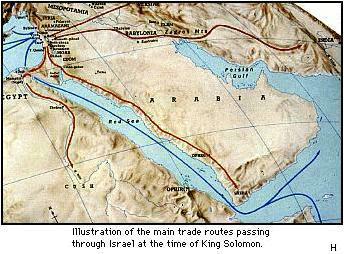
The choice of Solomon was a wise one. Besides being aesthetically gifted, he was without doubt a most able administrator and adroit diplomat. Having inherited his father's vast wealth, he cleverly exploited the trade routes which passed through his country between India, Persia, Arabia and Babylonia (Iraq) on the one hand, and Egypt, Athens, Rome and Carthage (Tunisia) on the other. It seems to be generally agreed that his annual personal income was about 23 tons (23.4 tonnes) of pure gold, i.e. worth about £225M (US$375M) at 1997 values (16).
He wasted little time initiating work on his father's grand design. He organised the labour force with attendant accommodation; opened up stone quarries; constructed special port facilities at Joppa (Jaffa/Tel Aviv) to handle the timber imports from Tyre; laid 50 miles (80 km) of new road from Joppa up to Jerusalem and excavated extensive water systems within Mount Moriah.
Originally the top of the Mount had been nearly 2500 feet (760 m) above sea level, although it stood only about 400 feet (120 m) above Jerusalem itself. Its sides sloped by as much as 45 degrees. During the course of site preparation, however, the hilltop was sliced off to provide a level platform on which to build the Temple. As a result the final height was reduced to 2420 feet (740 m) above sea level. When this was done, very large foundation stones are reported to have been sunk into the platform to a considerable depth. The whole of this preliminary work took four years before any start could be made on the Temple itself. Another three years and four months were needed to complete the project (17).
It might now perhaps be easier if one follows chronologically the sequence of events that led to the construction and fate of the First and Second Temples.
965 BCE
Solomon succeeded David as King of the United Israelite Kingdom of the Twelve Tribes. Taking their names and territories from north to south, they were:
Israel
964 BCE
Solomon ordered the start of preparations for the construction of the First Temple. Hiram, King of Tyre, a good friend of both he and his father, had already volunteered to provide all the timber such as cedar, pine and olive wood from the Lebanon in return for food for his own people and the gift of 20 small townships near the Sea of Galilee (19). The two kings sealed their agreement with prayers together on Mount Moriah.
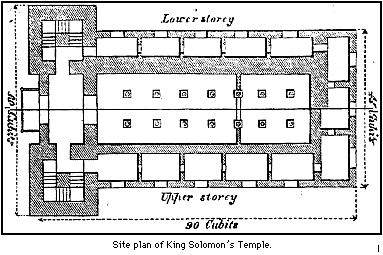
Solomon conscripted 30,000 foreign labourers to help Hiram. He also mustered 120,000 slaves to quarry and move the stone. This forced labour was under the overall direction of Adoniram, who was assisted by 3,300 supervisors. Only 550 Israelites were engaged on the project. They held positions of management and control of whom Adoniram was one. Whilst he may have been a stone mason by trade, he was first and foremost King Solomon's slave master (20). About 30 years later, and after Solomon had died, Adoniram was stoned to death for unrecorded reasons.
960 BCE
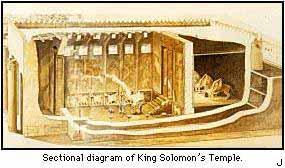
With the foundations in place, the structure took shape in the form of three sections: the porch or vestibule, or 'Ulam', was outside the Temple proper and faced east. It led, via the main entrance, into the body of the Temple, or 'Hekhal'. The Holy of Holies, or 'Debir', occupied one third of the Temple furthest from the main entrance. The combined internal measurements of the 'Hekhal' and 'Debir' were about 90 feet (27 m) long, 30 feet (9 m) wide and 40 feet (12 m) high. However, the floor of the Debir was raised about 10 feet (3 m) so that this chamber then formed a perfect cube of about 30 feet (9 m). A frontal staircase gave access to it. There may also have been a room underneath, but this is unconfirmed.
The Ark was to be positioned in the centre of the Debir, flanked by two large wooden gold-plated winged Cherubim. The whole of the Holy of Holies, or Sanctum Sanctorum, was to be shrouded from public view by linen curtains coloured red, blue and purple.
The walls of the Temple were constructed in an unusual manner. First were laid three courses of dressed stone, followed by one layer of interlocking cedar beams or ties, then another three courses of dressed stone, followed by another layer of timber, and so on (21). It has been suggested that the reason for this was to make the structure better able to withstand the occasional earth tremors in that region. (The second Temple was built similarly) Indeed, even today, many buildings between eastern Turkey and Afghanistan are built this way. Surprisingly, it is only in the last half of this century that this principle of structural elasticity, in respect of large buildings, has been re-adopted. It is now in widespread use in California and Japan.
Interconnecting annexes, established upon three floors, abutted three sides of the Temple. There were approximately 30 such rooms, each with one or more slitted windows to enable use by archers if defence was needed. None of these rooms had any access to the Temple itself: their entry was gained via doors and stairs let into each side of the porchway. The Temple itself had its own single entrance via the vestibule. There were never three entrances to the Temple itself, although there may well have been such entrances to the Temple precinct.
Initially, all stonework within the Temple, as well as that outside the whole structure, was clad completely in wooden panelling. The roof itself was almost flat, supported by joists of cedar which, in turn, were supported by seven pairs of pillars.
The reported absence of the use of metal tools in the construction of the Temple edifice has never been made clear; i.e. whether it was purely the lack of sound, or whether no metal tools at all were used. If the latter, it would have necessitated the preparation of timber beams and panelling well away from the site. Obviously metal tools had to be used in the underground quarry where, naturally, no noise would have been audible on the surface.
958 BCE
When the structure was nearing completion, Solomon invited a skilled foundryman from Tyre to embellish the Temple with gold, silver and bronze metal-work (22). Although he was called Hiram, ostensibly of the tribe of Naphtali, Freemasons have, over the last three centuries, come to know him as Hiram Abif. However, nowhere in the Old Testament does that name appear in this form. The origin of 'Abif' itself is unknown and about which there is still much speculation. A widely accepted view is that 'Hiram Abif' could be a translating corruption of the Hebrew 'Huram abi', namely 'the son of Huram'. At all events, he was never an architect, nor was he ever involved in the actual construction of the Temple, as has been commonly believed. On the other hand, the genius that he displayed in the scale and beauty of his craftsmanship, earned him a special relationship with Solomon.
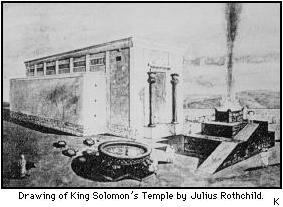
Using the great clay pits at Succoth on the east side of the Jordan Valley, 60 miles (100 km) northeast of Jerusalem, Hiram cast two great hollow pillars in bronze (each 25 feet (8 m) high and six feet (2 m) in diameter) and adorned them with capitals in the shape of huge bowls seven feet (2 m) deep, ornately decorated, and each rimmed with two rows of 100 pomegranates. These columns were erected and stood alone on either side in front of the vestibule at the east end of the Temple. Hiram named them 'Boaz' on the right (north) and 'Yachin' on the left (south), as viewed from outside the entrance.
He then cast a bronze circular cistern 15 feet (4.5 m) in diameter and with sides three inches (7.5 cm) thick, capable of holding 10,000 gallons (37,800 litres) of water, which he mounted upon twelve life-size bronze bulls. The whole structure was assembled opposite the Southeast corner of the Temple, and referred to as the 'Molten Sea' or 'Laver' (23). Its purpose was to provide the priests with ample water, obtained initially from the deep and large underground cisterns which had been recently excavated to supply the future citadel. Some of these cisterns still exist. Although two streams ran down either side of Mount Moriah, it was the larger one in the Kidron Valley, and which was augmented by water from the Gihon Spring, that provided the main supply to the cisterns by means of a series of tunnels and siphons.
Hiram then went on to erect a huge sacrificial altar in bronze, measuring 30 feet (9 m) square at the base and tiered to a height of 15 feet (4.5 m). Ten very large wheeled basins, together with numerous bronze lamp stands, sacrificial implements, and chariots were added. All this metal-work was heavily embellished with decorative embossing. Added to which, Hiram created an altar in gold for the Holy of Holies, as well as all plating, ornaments, lamps, jars, etc.; each beautifully worked in solid gold and silver. But above all, the surfaces of the whole edifice, both inside the Temple and outside, were clad with gold sheeting so that no part of the basic structure was evident.
There is no known record of the vast quantities of gold, silver, bronze and precious stones that were used (24), although rough calculations have suggested that about 20 tons (20.3 tonnes) of gold alone were utilised. At all events, it must have presented a stunning spectacle that would have been visible for miles around. Incidentally, there is no known record of the fate of Hiram Abif.
957 BCE
Palestine (as erroneously named by the Romans) around the first and second millennia BCE was fertile and well wooded. Yet, with a supposed Israelite population by now of about half a million, one might reasonably suspect an element of exaggeration in the accounts of the dedication of the Temple to which large numbers of the populace were witness. It was reported that a sacrifice of 22,000 head of cattle and 120,000 sheep took place (25).
It is perhaps interesting to note that appreciable deforestation occurred at the time of the Roman occupation. This was further exacerbated by the utterly indiscriminate and total destruction of the forests during the period that the Levant was within the Ottoman Empire (c. CE 1300-1700). The result was that the whole area was reduced to a bare and arid land from which progressive recovery has only been achieved over the last half of the 20th. century.
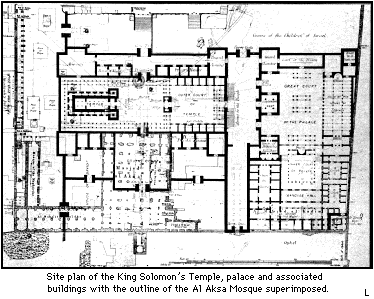
956 BCE
Solomon now continued with the construction of his own palace and the associated quarters for those responsible for the government of the kingdom. This, together with citadel walls and defences, took another 13 years, i.e. until 943 BCE.
940 BCE
Disbelieving the reports she had received about Solomon's splendour, the Queen of Sheba travelled 1700 miles (2750 km) from southern Yemen (Aden) on a state visit to see things for herself. It seems she came away greatly impressed (26).
931 BCE
Nine years later, Solomon died. His son Rehoboam succeeded him. However, a short while later, the kingdom divided; Rehoboam retained Judah, of which Jerusalem remained the capital. Jeroboam I was chosen to rule over the remaining tribes of Israel (27), which henceforth, at their wish, would include the tribes of Reuben and Simeon.
925 BCE
Rehoboam, by now in his fifth regnal year, had been allowing skirmishing parties to raid Egyptian settlements. The pharaoh, Ramesses II (mentioned at the beginning), whom it has since been established was also known as Shishak, decided to punish him by leading his army into Judah. The outcome was that a number of hill towns were destroyed. Jerusalem was captured and about to be treated likewise but, following a plea from Rehoboam, the city was spared in exchange for most of the Temple's moveable treasures. (28) Fortunately the Ark was spared and left in place. There now followed a period of relative tranquillity for the next three centuries or so.
690 BCE
The two kingdoms remained separate until, by common consent, Hezekiah, who had been King of Judah since 715 BCE, took control of a part of Israel as well. Hezekiah was one of the great kings of the day; his particular forte was the construction of many enormous stone structures, both civil and military. Several still exist. It was he who also extended the complex system of tunnels, siphons and cisterns under Mount Moriah to improve the water supply into Jerusalem.
597 BCE
After conquering Syria, Nebuchadnezzar II, King of Babylonia, went on to seize Israel and later Judah. Having successfully laid siege to Jerusalem, he imposed a series of puppet kings to govern it. This unsatisfactory state of affairs continued for the next ten years until the Jews revolted, and Nebuchadnezzar finally decided to crush all remaining resistance.
587 BCE
With the revolt suppressed, Nebuchadnezzar's forces sacked Jerusalem itself, stripping the Temple of all its gold sheeting and valuable artefacts. The latter, presumably, having been reproduced over the years to replace those seized by Ramesses II some three centuries previously. The Babylonians then broke up the two pillars, the laver and sacrificial altar before burning down the structure which had stood for over 370 years. They followed this by dismantling the citadel walls so thoroughly that little trace of them was left.
Sometime during this period, the Ark of the Covenant vanished completely, and was never referred to again in the Bible. One is forced to presume either, that this was because it was destroyed or, more intriguingly, because it was secreted away some time during the previous ten years, never to be rediscovered. It seems inconceivable that the High Priest would have passively allowed its capture. Equally, the removal of such a holy artefact, together with the profound religious significance that it exerted, could hardly have passed unnoticed or unrecorded. It is not unreasonable to suspect that it could have been hidden in the depths of Mount Moriah.
On the other hand, Jeremiah, in the Apocrypha, is reported to have stated clearly that he removed and hid the Ark in a cave outside Jerusalem and which he then sealed up (29).
Graham Hancock, in his BBC programme of 8th. August 1993, submitted another theory in that it might have been transported secretly to Aksum, the ancient former capital of Ethiopia. At all events, what ever the answer, its disappearance still remains the greatest Biblical mystery.
587 BCE (continued)
As a sequel to pillaging the Treasury, Nebuchadnezzar ordered some 5,000 of the most important and skilled Jews to be taken into exile at Babylon. This was done in four phases, spread over a number of years; the remaining Jews being left to 'till the land' (30). The Old Testament records that King Jehoiachin was taken along with them and subsequently released by the new Babylonish King Evilmoradach after 37 years in a prison (31). This has been questioned, as some now believe that Jehoiachin, aged 18, died in 597 BCE after a brief reign of only three months, and well before the Babylonian invasion. Moreover, Jehoiachin had been succeeded by Zedekiah (Tsidkiyáhu), although eventually the latter was left without authority over Jerusalem and its puppet kings.
Following the abortive revolt later that summer, Nebuchadnezzar, angered by Zedekiah's alleged treachery and ingratitude for past favours, forced the latter to witness the execution of his three sons before his own eyes were gouged out. Zedekiah was then taken into captivity in Babylon where he died soon afterwards in early 586 BCE.
539 BCE
There was little love lost between the Persians and the Babylonians: a modern parallel is that between the Iranians and the Iraqis. Cyrus, Emperor of Persia, succeeded in conquering Babylonia and then went on to take Syria, the whole of Israel and Trans-Jordan.
538 BCE
With the retaking of Jerusalem, and after almost 50 years in exile, Cyrus allowed the banished Jews to return to rebuild their Temple (32). Moreover, and most handsomely, he ordered the return to the Jews of all the treasures originally plundered by Nebuchadnezzar (33). Again, there was no mention of the Ark.
537 BCE
Preparation for the new Temple began. First, however, a more substantial level platform needed to be organised. This necessitated the erection of massive retaining walls, of which some of the stone blocks each weighed nearly 100 tons.
Work on the Temple itself then took shape, based upon a similar but much larger design, although without any annexes. The stone was quarried from beneath the Old City. This was done because of its white colour and fine texture. It has been said that Solomon too had obtained his stone from the same quarry. The quarry still exists underground and access may be achieved via the entrance situated between the Damascus and Herod's Gates. Nowadays, King Solomon's Quarries are used several times a year to conduct Masonic meetings.
Once again the roof was supported by 14 pillars. However, impressive though it was, the structure was not decorated nearly so lavishly as in the days of Solomon, nor were there any pillars at the porch. Recent exploration has revealed that the foundations around the south-east corner went to a depth of 160 feet (50 m) below ground level. It would mean that in those days these massive walls could have been nearly 300 feet (90 m) high in places. This, though, is no longer apparent as, over the centuries, the steep valleys adjoining Mount Moriah have become filled with excavation rubble and building debris so that now they have become quite shallow.
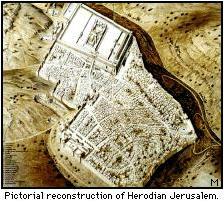
514 BCE
After numerous delays, resulting in the work being spread over 23 years, the Second Temple was finally completed and re-dedicated in the reign of Darius I, Emperor of Persia (34). The time lapse between the dedication of the First Temple (957 BCE) and reconstruction of the second Temple (537 BCE) was about 420 years, and not about 500 years as some have contended.
During the latter part of the first century BCE, King Herod the Great (37-4 BCE) enlarged the area of the platform and greatly enhanced the second Temple in an unsuccessful attempt to gain popularity. He created a huge cloistered quadrangle or series of porticos with buildings for both staff and animals. This was further protected by a large fort and tower, later called Antonio. Despite sundry attacks by the Syrians, Greeks and Romans, and interspersed by periods of neglect, the Temple remained functional for nearly 600 years.
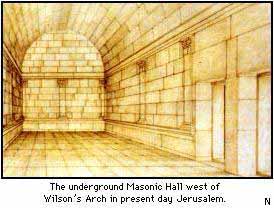
It is interesting to note that, during the period of the Jewish Hasmonaean Dynasty (152 - 37 BCE), a beautifully appointed stone chamber (84 x 60 feet or 26 x 18 m) was constructed underground beneath the former Council House (or Sanhedrin) in Jerusalem. It was used for many years by the operative masons of that period. They believed that it had been used for arcane religious rites at the time of Solomon. However, there is no firm evidence to support this. It still exists, and is located just west of Wilson's Arch near the Wailing Wall. It is regarded as one of the finest examples of such work from the late Hellenistic period.
CE 70
Not long after the death of Jesus on Friday, 30th. March, CE 36, there followed the lengthy and brutal occupation by the Romans of Judah in general, and Jerusalem in particular. Once again, the Jews rebelled. As a result, Emperor Vespasian sent Titus to restore order. This he did though not without heavy bloodshed in the face of fierce Jewish opposition which finally centred upon their defence of Jerusalem. The Roman soldiers, in their rage, plundered and destroyed the Temple despite Caesar's specific orders forbidding this. It was never rebuilt. A graphic personal eye-witness account may be found in the writings of Josephus Flavius, himself a Jew, who was a former military general, and then historian and diplomat. At one stage, he was employed as a peace negotiator between the Romans and the Jews. It was almost providential that Josephus was allowed to remove all the sacred scrolls from the Temple before its demolition. Whilst tragically the scrolls have since been lost, Josephus at least had full reference to them to help write up large parts of ancient history with considerable accuracy and authority. His work is still available for study.
Once the Romans had done their worst, all Jews were banished from the whole of Jerusalem for the next 150 years. Thereafter, the area within the citadel walls was retained for the exclusive use of Gentiles until the Muslim onslaught in CE 638 under Calif Umar el-Sharif. This took place in September CE 622, just 16 years after the founding of the Muslim religion by Mohammed Ibn Abdullah (CE 570-632).
By CE 691, Calif Abdul Malik had cleared the area within the citadel and erected the Mosque of Sakhra (Dome of the Rock) immediately adjacent to the original site of Solomon's Temple. Years later the Al Aksa Mosque was added opposite and equally close to that site.
Extensive official archaeological excavations have been carried out within parts of the citadel over the past 120 years. However, the Muslims firmly refuse any such investigations either within or beneath the perimeter walls of the two mosques. Consequently, it has never been possible to determine precisely the foundations of the First Temple which, according to Josephus, "had been laid very deep in the ground."
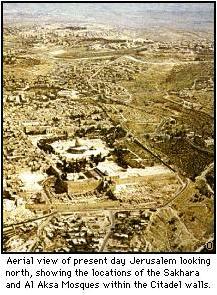
It is perhaps worth bearing in mind that, from the time the Jews returned to Canaan (around 1400 NC), and for the next 2000 years or so, the territory occupied by their tribes varied surprisingly little. Their boundaries, in the main, lay from the Mediterranean coastline (The Great Sea) eastwards for almost 80 miles (130 km) in places; and southwards from the Golan Heights for about 150 miles (240 km) to the southern end of the Dead Sea.
This, together with the bitter resentment engendered by the imposition of Muslim mosques upon David's original site, goes some way to explain why the present State of Israel is so adamant about its retention of the whole of Jerusalem. It also goes a long way to explain the deep divisions within the Israeli nation today: between those struggling for what they consider to be their birthright, and those yearning for peace with their Arab neighbours.
The Jews are back in their land. A land which they all profoundly believe to be their's by Divine Right; it having been given to them in perpetuity by the Almighty (35).
In the Egyptian Museum at Turin, there exists a papyrus document which was composed in the early 19th. Dynasty. Although badly deteriorated, it nevertheless lists in some detail, amongst other things, all known pharaohs from the 1st. Dynasty (c. 2920 NC) up to those of the 18th. Dynasty (1194-952 NC). Allowing for partial damage and deterioration over the years, each pharaoh is shown with his or her length of reign in years, months and days. It is known as 'The Royal Canon of Turin'.
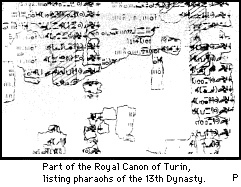
Throughout the Middle East almost all records previous to this Canon were written on wet clay and then baked. In every instance such tablets were dated in relation to the lunar month and regnal year of the appropriate king; whether Egyptian, Babylonian or Assyrian. For example, in the 13th. Dynasty, Pharaoh Iayib reigned for 10 years 8 months 28 days, followed by Pharaoh Ay who reigned for 23 years 8 months 18 days. Obviously, the ancients did not have our advantage of relating events to the Common Era.
Hitherto, Egyptologists have been inclined to add together most, if not all, the reigning periods in order to obtain a time scale. It is only recently that there has come the realisation that many rulers functioned either as contemporaries of adjoining kingdoms or as co-regents of the same kingdom. Thus, the only completely reliable method of assessing the degree of such 'overlaps', has been to resort to astronomical dating, or rather retro-dating, that can be proven scientifically by modern standards.
For centuries the ancients regarded eclipses of the sun and positions of the planet Venus with special veneration. Mention of such events have been deciphered on tablets dug up in Egypt, the Levant and Syria. As a result, it has now been possible to establish three specific dates with total accuracy and confidence. These dates can be taken as the 'bench marks' of the New Chronology of the pharaohs.
The years in question are: 664 BCE; 1012 NC and 1540 NC. Very briefly, the methodology to achieve this has been as follows:
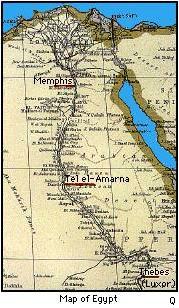
664 BCE
For a long time this datum has been accepted in ancient chronology. It is based upon the unalterable fact that King Ashurbanipal of Assyria invaded Egypt that year and sacked the city of Thebes (Luxor) as a penalty for the revolt led by King Taharka and which cost him his life. This episode has been inscribed upon contemporary monuments, as well as surviving accounts written at that time in Babylon, Greece and Rome. It also confirms the coronation of Pharaoh Psamtek I of the 26th. Dynasty.
The introduction of the two extra datum points has dramatically revised the scheduling of Biblical history for the previous 1000 years.
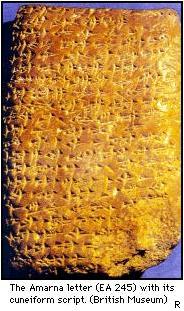
1012 NC
Hitherto, conventional chronology has placed the 18th. Dynasty in the time span of 1539-1295 BCE. The fifteen pharaohs forming this dynasty are well recorded and are not disputed. However, the historical relationship between the Egyptians and Israelites has had to be refined more accurately.
In CE 1887, a peasant woman of Tell el-Amarna, nowadays a small village on the Nile and midway between Cairo and Luxor, dug up 380 clay tablets from beneath the floor of a ruined mudbrick house. They subsequently transpired to be part of the contents of the 'House of Correspondence of Pharaoh'. The majority of these letters were either from notables of the Levant or Pharaoh's own file copies of replies. They also included letters to both Akhenaten and his Queen Nefertiti. It seems that all these letters were lost when the then city of El Amarna was abandoned (for whatever reason) early in the reign of Tutankhamun.

These letters also contained reports of military campaigns in Canaan, including David's raids and his seizure of Jerusalem. One vital document helped to pin-point the death of Amenhotep III in 1012 NC. It was from Abimilku, King of Tyre, commiserating upon the death of Amenhotep. It went on to describe a disastrous fire in the palace archives of King Nikmaddu II at Ugarit (about 120 miles (200 km) up the coast from Tyre). Subsequent archaeological digs beside the palace ruins found a blackened tablet which described the total eclipse of the sun at sunset in April/May of that year, and which was watched by Nikmaddu and his priests.
Total eclipses of the sun occur at the same place, on average, every 360 years. Only once in recorded history has this happened near sunset. Advanced computer technology (by M.I.T.) has been able to calculate the exact time as 6.09 pm. on 9th. May 1012 NC, and 30 minutes before sunset. Clearly, therefore, Akhenaten must have succeeded Amenhotep that year. Consequently, it has been possible to bring forward the 18th. Dynasty's time span by as much as 345 years to 1194-952 NC.
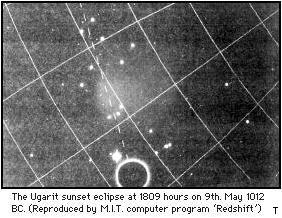
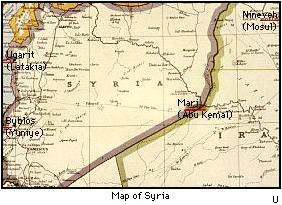
1540 NC
Tablets discovered at Nineveh (now Mosul, on the river Tigris in Northern Iraq), have been certified as copies from the reign of King Ammisaduga of the 1st. Dynasty of Babylon. Such records include the precise description of the risings and settings of the planet Venus. These observations are known to have coincided exactly with Ammisaduga's reign of 21 years. Use now had to be made of the Venus cycle; i.e. the period between exact repetitions of its risings and settings, and which average 60 years.
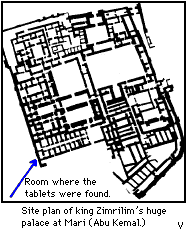
Old Babylonians dated their documents in relation to the days of the lunar month, beginning with the first crescent of the moon. The dating of these tablets, taken in conjunction with the specific positions of Venus, have been subjected to further advanced computer analysis in much the same way as described in the 1012 NC datum. The result has shown that Ammisaduga became king in 1419 NC and died in 1398 NC. Moving back from this, and knowing the names of all eleven kings of that dynasty, it has been possible to determine the reign of the 6th. and most famous (or infamous) of those kings, namely Hammurabi (1565-1522 NC). In his 35th. regnal year (1531 NC), Hammurabi attacked and destroyed the huge yet beautiful palace of Zimrilim, King of the city-state of Mari (now known as Abu Kemal, on the river Euphrates in eastern Syria). Zimrilim perished with it.
In CE 1933, a French archaeologist unearthed 25,000 tablets from the archive of that palace. The last date traced from those tablets showed that Zimrilim must have died in his 6th. regnal year, having reigned 1536-1531 NC. A particular tablet, however, was an inventory of gifts on the occasion of his enthronement, including a solid gold cup. It had come from Yantin, in his 9th. regnal year as King of the city-state of Byblos (now Yuniye, 13 miles (20 km) north of Beirut) and which, in those days, formed part of the Egyptian empire. Thus Yantin must have been enthroned in 1544 NC. Sadly, at this point, any archaeological hope of establishing an Egyptian connection went cold.
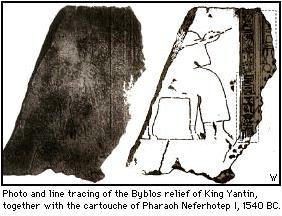
It is true to say that every archaeologist lives in the hope that perhaps once in a lifetime he or she may benefit from some dramatic and unexpected bonus, even indirectly, such as in the case of the Amarna woman's discovery. In CE 1952, there was just such an instance.
Arising from a comprehensive excavation of Byblos, a large limestone slab was uncovered with Egyptian hieroglyphics carved upon it. It showed Yantin in his 5th. year as King of Byblos. What was astonishing, however, was that beside Yantin's inscription was the partially damaged cartouche of Pharaoh Neferhotep in his first regnal year. It therefore followed that Neferhotep must have begun his reign in 1540 NC, thereby bringing forward the re-dating of the 13th. Dynasty by 127 years to 1632-1440 NC.
'KJ' signifies reference to the King James Bible (Old Testament)
'GN', the Good News Bible (Old Testament)
'AP', the Apocrypha.
| 1 | Exodus 12:40 | KJ | The Sojourn. |
| 2 | Exodus 1:7-10 | KJ | Alarm at the increasing numbers of Israelites. |
| 3 | Exodus 7:17-12:30 | KJ | The ten plagues in Egypt. |
| 4 | Exodus 12:37 | GN | The reported exodus of 600,000 men. |
| 5 | Exodus 13:19 | KJ | Joseph's burial remains are removed. |
| 6 | Exodus 14:16 & 27 | KJ | Moses parts the Red Sea. |
| 7 | Exodus 32:15/35:29 | GN | The two stone Tablets. |
| 8 | Baruch 2:28 | AP | Writing the Ten Commandments. |
| 9 | Exodus 25:10-16 | KJ | The construction of the Ark. |
| 10 | I Samuel 4:4-11 | KJ | The Ark is lost in battle. |
| 11 | I Samuel 7:2 | GN | The Ark is recovered. |
| 12 | I Chronicles 21:5-14 | GN | David's first census. |
| 13 | II Samuel 24:18-24 | KJ | David buys Mount Moriah. |
| 14 | I Kings 1:34 & 39 | KJ | Solomon is anointed King. |
| 15 | I Chronicles 28:19 | GN | Solomon's undertaking to his father David. |
| 16 | II Chronicles 9:13-14 | GN | Solomon's annual income. |
| 17 | I Kings 6:37-38 | KJ | Time taken to build the First Temple. |
| 18 | Genesis 50:2-28 | KJ | The Twelve Tribes of Israel. |
| 19 | I Kings 5:8-11 | KJ | Hiram, King of Tyre, supplies Solomon. |
| 20 | I Kings 5:13-16 | KJ | Adoniram oversees the labour force. |
| 21 | I Kings 7:36 | KJ | Layout of the Temple walls. |
| 22 | I Kings 7:13-14 | GN | Hiram Abif invited to embellish the First Temple. |
| 23 | I Kings 7:23-26 | KJ | Constructing the Molten Sea. |
| 24 | I Kings 7:47 | KJ | The various precious metals used are unrecorded. |
| 25 | II Chronicles 7:5 | KJ | Sacrifice at the dedication |
| 26 | II Chronicles 9:1-6 | GN | Queen of Sheba visits Jerusalem. |
| 27 | II Chronicles 10:12 | GN | Solomon's Kingdom divided. |
| 28 | II Chronicles 12:2-9 | KJ | Ramesses II loots the Temple. |
| 29 | II Maccabees 2:4-7 | AP | Jeremiah hides the Ark. |
| 30 | II Kings 25:8-17 | KJ | First Temple is destroyed. |
| 31 | Jeremiah 52:31-34 | GN | Jehoiachin is released. |
| 32 | Ezra 1:1-3 | GN | The exiled Jews are freed to return to Jerusalem. |
| 33 | Ezra 6:5 | KJ | The First Temple's treasures restored. |
| 34 | Ezra 6:15 | GN | The Second Temple is dedicated. |
| 35 | Baruch 2:34-35 | AP | God pledges Israel to the Jews. |
Note: From time to time, there were many minor pharaohs or local kings, particularly during the Intermediate Periods. They have been deliberately excluded to avoid complication. Ruling Queens are annotated (Q).
Middle Kingdom Period |
Middle Bronze Age | ||
| 12th. Dynasty | |||
| Span = 1813-1663 | Formerly 1937-1759 (Old Chronology); i.e. a revision forwards of 124 years. | ||
| 1813-1786 | Amenemhat I | ||
| 1786-1741 | Senuseret I | ||
| 1741-1731 | Amenemhat II | ||
| 1731-1712 | Senuseret II | ||
| 1712-1682 | Senuseret III | 1683: Joseph kidnapped. | |
| 1682-1636 | Amenemhat III | 1670: Joseph made Vizier to Egypt. | |
| 1662: Jews arrive. | |||
| 1653-1645 | Amenemhat IV | (Co-Regent for 8 years) 1645: Jacob dies. | |
| 1636-1633 | Neferusobek (Q) | ||
Second Intermediate Period |
|||
| 13th. Dynasty | |||
| Span = 1632-1440 | Formerly 1759-1621 (Old Chronology); ie. a revision forwards of 127 years. | ||
| 1632-1630 | Khutawyre (Wegaf) | ||
| 1630-1625 | Sekhemkare | ||
| 1625-1619 | No king | Interregnum exercised by Joseph. | |
| 1619-1616 | Amenemhat V | ||
| 1616-1611 | Sehetepibre I | ||
| 1611-1606 | Iufni | ||
| 1606-1601 | Sankhibre | ||
| 1601-1596 | Smenkhkare | c.1600: Joseph dies, aged 100+ years. | |
| 1596-1591 | Sehetepibre II | ||
| 1591-1586 | Sewadjkare | ||
| 1586-1581 | Nedjemib...re | ||
| 1581-1579 | Sobekhotep I | ||
| 1579-1578 | Renseneb | ||
| 1578-1573 | Awibre Hor | ||
| 1573-1568 | Sedjef...kare | ||
| 1568-1563 | Sobekhotep II | ||
| 1563-1558 | Khendjer | ||
| 1558-1553 | Mermesha | ||
| 1553-1548 | Inyotef | ||
| 1548-1543 | ...set | ||
| 1543-1540 | Sobekhotep III | ||
| 1540-1530 | Neferhotep I | 1540 Datum | |
| 1530-1529 | Sihathor | ||
| 1529-1508 | Sobekhotep IV (also k/a Khenophres) | 1527: Moses born. | |
| 1517: Israelites put in bondage. | |||
| 1508-1503 | Sobekhotep V | ||
| 1503-1493 | Iayib | ||
| 1493-1470 | Ay | 1493: Moses flees into exile. | |
| 1470-1468 | Sobekhotep VI | ||
| 1468-1467 | Sankhreensewadjtu | ||
| 1467-1464 | Ined | ||
| 1464-1459 | Hori | ||
| 1457-1455 | ... lost | ||
| 1455-1450 | ... lost | ||
| 1450-1448 | ... lost | 1449: Moses returns from exile, aged 78. | |
| 1448-1440 | Dudimose (also k/a Tutimaos) | 1448-7: The ten plagues. | |
| 1447: The Exodus starts. Joshua born. | |||
| Note: There were considerable overlaps between the 14th. and 17th. Dynasties. In some instances amounting to 108 years. | |||
New Kingdom Period |
Iron Age | ||
| 18th. Dynasty | |||
| Span = 1194-952 | Formerly 1539-1295 (Old Chronology); i.e. a revision forwards of 345 years. | ||
| 1194-1170 | Ahmose | ||
| 1170-1150 | Amenhotep I | ||
| 1150-1139 | Thutmose I | ||
| 1139-1138 | Thutmose II | ||
| 1138-1116 | Hatshepsut (Q) | (de facto ruler) | |
| 1138-1085 | Thutmose III | (Nominal Co-Regent for 22 years) | |
| 1085-1059 | Amenhotep II | ||
| 1059-1050 | Thutmose IV | ||
| 1050-1022 | Amenhotep III | 1037: Saul becomes King. | |
| 1022-1006 | Akhenaten | (Co-Regent for 11 years) | 1012 Datum |
| 1011-1007 | Nefertiti (Q) (Also k/a Neferneferuaten) | (Co-Regent for 4 years) | |
| 1010: David becomes King. | |||
| 1006-1003 | Smenkhkare | ||
| 1003-995 | Tutankhamun | ||
| 995-979 | Ay (Kheperkheperure) | ||
| 979-952 | Haremheb | 965: Solomon becomes King. | |
| 957: 1st. Temple dedicated. | |||
| 19th. Dynasty | |||
| Span = 952-851 | Formerly 1295-1186 (Old Chronology); i.e. revision forwards of 343 years. | ||
| 952-951 | Ramesses I | ||
| 951-936 | Seti I | ||
| 936-871 | Ramesses II (Also k/a Shishak) | 931: Solomon dies. | |
| 925: Ramesses raids 1st. Temple. | |||
| 871-866 | Merenpath | ||
| 866-862 | Amenesse | ||
| 862-857 | Seti II | ||
| 857-853 | Siptah | ||
| 853-851 | Tausert (Q) | ||
| Note: There were considerable overlaps between the 20th. and 25th. Dynasties. In some instances amounting to 71 years. | |||
Late Kingdom Period |
|||
| 26th. Dynasty | |||
| Span = 689-525 | Contemporary with rulers of 25th. Dynasty for 33 years. | ||
| 689-681 | Ameris | The Chronology henceforth remains unchanged. | |
| 681-669 | Tefnakht II | ||
| 669-668 | Nekauba | ||
| 668-664 | Necho I | ||
| 664-610 | Psamtek I | 664 Datum | |
| 610-597 | Necho II | ||
| 597-583 | Psamtek II | 538: Jews return from exile. | |
| 31st. Dynasty | |||
| Span = 525-304 | |||
| 525-522 | Cambyses | ||
| 522-494 | Darius I | 514: 2nd. Temple dedicated. | |
| 494-380 | Not known | ||
| 380-362 | Nectanebo I | ||
| 362-343 | Nectanebo II | ||
| 343-335 | Not known | ||
| 335-332 | Darius III | ||
| 332-323 | Alexander III | ||
| 323-316 | Arrhidaeus | ||
| 316-304 | Alexander IV | ||
| 323-304 | Not known | ||
| Ptolemaic Period | |||
| Span = 304-30 | |||
| 304-284 | Ptolemy I | ||
| 284-266 | Ptolemy II | ||
| 266-221 | Ptolemy III | ||
| 221-51 | Not known | ||
| 51-30 | Cleopatra VII (Q) | ||
| 44-30 | Ptolemy XV | ||
| Roman Period | |||
| Span = 58BCE-CE81 | |||
| 58-44 | Caesar | ||
| 44-27 | Triumvirate: Antony, Lepidus & Octavian (renamed Augustus). | ||
| 27BCE-CE14 | Augustus | 6? BCE: Jesus is born. | |
| 4 BCE: King Herod dies. | |||
| 14-37 | Tiberius | CE 36: Jesus is crucified. | |
| 37-41 | Caligula | ||
| 41-54 | Claudius | ||
| 54-68 | Nero | ||
| 68-69 | Golba | ||
| 69-69 | Otho | ||
| 69-69 | Vitelius | ||
| 69-79 | Vespasian | CE 70: Romans destroy 2nd. Temple. | |
| 79-81 | Titus | ||
Linear
Liquids
Solids
| United Monarchy | ||||
| Span = 1037-930 | ||||
| 1037-1017 | Saul (in real life, known as Labayu) | |||
| 1017-1010 | Ishbaal | |||
| 1010-965 | David | |||
| 965-931 | Solomon | |||
| Divided Monarchy | ||||
| Span = 930-690 | ||||
| Judah | Israel | |||
| 930-913 | Rehoboam | 930-909 | Jeroboam I | |
| 913-910 | Abijah | 909-908 | Nadab | |
| 910-869 | Asa | 908-885 | Baasha | |
| 869-848 | Jehoshaphat | 885-884 | Elah & Zimri (Jointly) | |
| 848-841 | Jehoram | 884-880 | Tibni | |
| 841-841 | Ahaziah | 880-873 | Omri | |
| 841-835 | Athaliah | 873-853 | Ahab | |
| 835-796 | Joash | 853-852 | Ahaziah | |
| 796-767 | Amaziah | 852-841 | Joram | |
| 767-739 | Azariah | 841-813 | Jehu | |
| 739-731 | Jotham | 813-798 | Jehoahaz I | |
| 731-715 | Ahaz | 798-781 | Jehoash | |
| 715-690 | Hezekiah | 781-753 | Jeroboam II | |
| 753-752 | Zechariah | |||
| 752-752 | Shallum | |||
| 752-741 | Menahem | |||
| 741-739 | Pekahiah | |||
| 739-731 | Pekah | |||
| 731-722 | Hoshea | |||
| 722-690 | Under Assyrian rule | |||
| Re-United Monarchy | ||||
| Span = 690-586 | ||||
| 690-686 | Hezekiah | (Formerly King of Judah 715-690) | ||
| 686-642 | Manasseh | |||
| 642-640 | Amon | |||
| 640-609 | Josiah | |||
| 609-609 | Jehoahaz II | |||
| 598-597 | Jehoiachin | 597: Dies after reigning three months. | ||
| 597-586 | Zedekiah | 597: Nebuchadnezzar invades Israel & Judah. | ||
| 587: Zedekiah blinded. Israelites exiled. | ||||
| 1700NC | Joseph the Patriarch is born in Canaan. |
| 1683 | Kidnapped by seven of his brothers and thrown into a well; later sold to a passing caravan heading for Egypt. There sold to Potiphar, head of the Royal Guard. Pharaoh Amenemhat became impressed by Joseph's logic and foresight. |
| 1670 | Appointed Vizier; the second highest position in Egypt. |
| 1662 | Invites his father, Jacob, with 70 relations plus other Israelites, to emigrate to Egypt to escape the existing famine in Canaan. |
| 1645 | Jacob dies. |
| c.1600 | Having served 10 Pharaohs, Joseph dies and is buried at Avaris. |
| 1527 | Moses is born near Memphis and is adopted as a Prince of Egypt. |
| 1517 | Israelites are placed in bondage and subjected to widespread infanticide. |
| 1493 | Having led many successful military campaigns, Moses incurs the jealousy of Pharaoh Ay and is obliged to flee in exile to Saudi Arabia where he later marries. |
| 1449 | Moses returns and pleads for the release of the Israelites. The Pharaoh refuses and the ten plagues begin. |
| 1447 | The tenth disaster persuades Pharaoh Dudimose to free the Israelites. The Exodus begins and Joshua is born on the way to Mount Sinai. |
| 1410 | On arrival at the River Jordan, Moses dies. Joshua takes over and begins the invasion of Canaan with the destruction of Jericho. |
| 1397 | Joshua dies and the 12 Tribes are each ruled by a series of Judges for 360 years. |
| 1037 | Saul is selected by Samuel (the last Judge) as the first King of a United Israel. |
| 1018 | Saul commits suicide after losing the battle of Gilboa. He and three of his sons are decapitated and put on display. |
| 1010 | Upon the death of Saul's remaining son, Ishbaal, David seizes the kingship of Israel. |
| 965 | Solomon becomes King and builds the First Temple at Jerusalem. |
| 931 BCE | Solomon dies and Israel splits into two kingdoms. |
| 925 | Pharaoh Ramesses II (also known as Shishak) invades Canaan and loots the Temple at Jerusalem. |
| 690 | Hezekiah reunites Judah with part of Israel. |
| 598 | After reigning just three months, Hezekiah's sixth successor, Jehoiachin (aged 18), is believed to have died. |
| 597 | Zedekiah becomes King and, for nearly 11 years, he resolutely resists the invasion of Nebuchadnezzar II despite being offered various favours. |
| 587 | Zedekiah is captured. Furious at being spurned, Nebuchadnezzar orders the execution of Zedekiah's three sons. Zedekiah himself has his eyes gouged out and is taken off to Babylon followed, in stages, by 5000 Israelites. Meanwhile Jerusalem is sacked, including the Temple. |
| 586 | Some six months after capture, Zedekiah dies as the last King of Israel. |
| 538 | Cyrus, Emperor of Persia, frees the Israelites to return to Jerusalem. |
| 514 | The Second Temple at Jerusalem is completed. |
| 12 | Herod the Great embellishes part of the exterior of the Second Temple and enlarges the Citadel. |
| c.6? | Jesus is born. |
| 4 | Herod dies. |
| CE 36 | Jesus is crucified on Friday, 30th. March. |
| CE 70 | Romans destroy the Second Temple and banish the Jews from Jerusalem for the next 150 years. |
| M.N. Adler | (Paper) The Temple at Jerusalem. | 1887 |
| D. Baly | Geography of the Bible. | 1974 |
| M. Bietak | Egypt and Canaan during the Middle Bronze Age. | 1991 |
| J. Brand | Some Observations on the Second Temple Edifice. | 1960 |
| J. Bright | A History of Israel. | 1972 |
| W.G. Dever | Monumental Architecture in Ancient Israel. | 1962 |
| J. Ferguson | The Temples of the Jews. | 1878 |
| R.L. Fox | The Unauthorised Version. | 1991 |
| C.H. Gordon & G.A. Rensburg | The Bible and the Ancient Near East. | 1997 |
| M. Haran | The Ark and the Cherubim. | 1959 |
| M. Haran | Temples and Temple Service in Ancient Israel. | 1978 |
| J.H. Hayes | A History of Ancient Israel - Judah. | 1986 |
| S. Herrmann | History of Israel in Old Testament Times. | 1981 |
| V. Hurowitz | 'I have built you an Exalted House'. | 1993 |
| W. Keller | The Bible as History. | 1989 |
| K.M. Kenyon & P.R.S. Moorey | The Bible and Recent Archaeology. | 1978/1987 |
| K.A. Kitchen | Pharaoh Triumphant. | 1982 |
| J.M. Miller & J.H. Hayes | A History of Ancient Israel and Judah. | 1986 |
| E.W. Nicholson | Exodus and Sinai in History and Tradition. | 1973 |
| M. Noth | History of Israel. | 1960 |
| J.B. Pritchard | (Ed.) The Times Atlas of the Bible. | 1987 |
| D. M. Rohl | A Test of Time - Vol.1. | 1995 |
| G. St.Clair | The Buried City of Jerusalem. | 1887 |
| R.B.Y. Scott | The Pillars of Jachin and Boaz. | 1939 |
| J.A. Soggin | A History of Israel: from the Beginnings to the Bar Kochba Revolt. | 1984 |
| R. de Vaux | Ancient Israel - Its Life and Institutions. | 1958/1960 |
| E. Thiele | The Mysterious Numbers of the Hebrew Kings. | 1983 |
| G. Vermes | The Dead Sea Scrolls: Qumran in Perspective. | 1982 |
| C. Warren | Underground Jerusalem. | 1876 |
| C. Warren | The Temple or the Tomb. | 1880 |
| L. Waterman | (Paper) The Damaged Blueprints of the Temple of Solomon | 1943 |
| W. Whiston | (Trans.) The Complete Works of the Learned and Authentic Jewish Historian, Flavius Josephus, (CE 37-98). | 1850 |
| C.W. Wilson & C. Warren | The Recovery of Jerusalem. | 1871 |
I remain indebted to the following for their critiques and guidance, without which much of this presentation would have had less substance:
Rev. Peter Davies, Principal, Elim Bible College, Nantwich, U.K.
Professor Michael Goulder, Dean, School of Continuing Studies, University of Birmingham, U.K.
Rev. Canon Michael Hocking (Former Arch Deacon of Jerusalem), U.K.
Rev. Dr. Stephen B. Dawes, Chairman, Cornwall District of Methodist Churches, U.K.
Mr George Edison, Shepherd, Montana, U.S.A.
Dr. David M. Rohl, former Chairman, Institute for the Study of Interdisciplinary Sciences, London, U.K.
Rabbi David Roller, Livermore, California, U.S.A.
Dr. Daniel N. Farhey, Haifa, Israel.
I am also immensely grateful for the generosity of the following for allowing me to make use of those illustrations as indicated by their reference letters:
From 'The Times Atlas of the Bible', by courtesy of Times Books Ltd, imprint of Harper Collins Ltd., London, U.K.:
Prints: C, D, F, H, M and N.From 'A Test of Time', by courtesy of Dr. David M. Rohl.:
Prints: A, B, P, R, S, T, V and W.By courtesy of Vaughan Tregenza, Esq., Penzance, Cornwall, U.K.:
Prints: G, J and O.The following prints are from sources published more than 50 years ago and are now out of copyright:
Prints: E, I, K, L, Q and U.